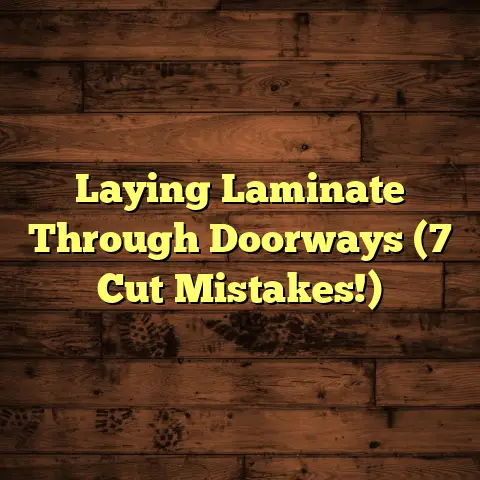Floor Beds For Kids: Safe? (7 Things to Know!)
I’m Mike, a flooring contractor with over 15 years of experience.
You might be wondering, “What does flooring have to do with floor beds?”
Well, a safe floor bed starts from the ground up!
I’ve seen firsthand how crucial the right flooring and setup are for creating a secure environment for your little ones.
And today, let’s dive into the rising trend of floor beds for kids.
It’s a topic I get asked about a lot, and I’m here to give you the lowdown on their safety and practicality.
Floor beds are gaining popularity, but are they right for your family?
Let’s explore!
What is a Floor Bed?
So, what exactly is a floor bed?
Simply put, it’s a mattress placed directly on the floor, or very close to it, unlike traditional beds with frames and box springs.
They’re typically used in children’s rooms to promote independence and freedom of movement.
Think of it as a minimalist approach to sleep, offering a unique design aesthetic.
You’ll find variations in style, materials, and overall look.
Some are basic mattresses on the floor, while others incorporate low platforms or simple wooden frames.
Montessori-style floor beds are especially popular, designed to encourage self-sufficiency.
These often feature a low barrier or lip around the mattress to provide a sense of security without restricting movement.
Historically, floor beds aren’t new.
Many cultures around the world have used floor sleeping arrangements for centuries, often out of necessity or as a cultural norm.
In some Eastern cultures, sleeping on the floor is believed to have health benefits, such as better spinal alignment.
The Safety Debate
Now, let’s get to the heart of the matter: safety.
Are floor beds really safe for kids?
The biggest safety concerns revolve around potential risks like falls and injuries.
While the risk of falling from a floor bed is obviously lower than from a raised bed, it’s not zero.
Young children, especially toddlers, might still roll off the mattress during sleep.
And the type of flooring plays a role, as hard surfaces like tile or hardwood can increase the risk of injury.
Age appropriateness is another key factor.
Floor beds are generally considered suitable for children who can independently crawl, roll over, and get up.
This usually starts around six months of age, but every child develops at their own pace.
For younger infants, the American Academy of Pediatrics (AAP) recommends a firm, flat sleeping surface, such as a crib mattress, to reduce the risk of SIDS (Sudden Infant Death Syndrome).
Source: American Academy of Pediatrics
Benefits of Floor Beds for Kids
Okay, so we’ve talked about the potential risks.
But what about the benefits?
Floor beds can actually offer several advantages for a child’s development.
One of the biggest is promoting independence.
Because the child can easily get in and out of bed, they have more freedom to explore their environment and make choices for themselves.
This can foster a sense of self-sufficiency and confidence.
Floor beds can also enhance room design and space utilization.
They create a more open and airy feel, making the room seem larger and less cluttered.
Plus, without a bulky bed frame, you have more space for other activities, like playing or reading.
I’ve heard countless stories from parents who have successfully transitioned to floor beds.
One mom told me how her toddler, who used to resist bedtime, now eagerly climbs into her floor bed and snuggles up with her favorite books.
It’s all about creating a positive and inviting sleep environment!
Guidelines for Safe Floor Bed Setup
Alright, let’s get practical.
How do you set up a floor bed safely?
Here’s a comprehensive checklist:
-
Mattress Choice: Opt for a firm mattress that provides adequate support. Avoid overly soft mattresses that could pose a suffocation risk for infants.
-
Room Layout: Ensure the area around the floor bed is clear of hazards. Remove any sharp or hard objects that could cause injury if your child rolls off the mattress.
-
Safety Features: Consider adding a low barrier or guardrail around the mattress, especially for younger children. This can help prevent falls without restricting movement.
-
Flooring: As a flooring contractor, I can’t stress this enough! If you have hard flooring, like tile or hardwood, consider adding a soft rug or padded mat around the floor bed to cushion any falls.
-
Bedding: Use fitted sheets and avoid loose blankets or pillows that could pose a suffocation risk for infants. Sleep sacks or wearable blankets are a safer alternative.
Creating a safe sleep environment is paramount.
Keep the room at a comfortable temperature, ensure good ventilation, and use a nightlight to provide soft illumination.
Transitioning to a Floor Bed
Making the switch from a crib or traditional bed to a floor bed can be a big change for both you and your child.
Here are some tips to make the transition smoother:
-
Start Slowly: Introduce the floor bed gradually. You might start by having your child nap on the floor bed during the day before transitioning to nighttime sleep.
-
Make it Fun: Get your child involved in setting up their floor bed. Let them choose their bedding or decorate the area around the mattress.
-
Be Consistent: Establish a consistent bedtime routine to help your child adjust to the new sleep environment.
-
Address Concerns: Talk to your child about any concerns they might have about sleeping on the floor. Reassure them that it’s a safe and comfortable place to sleep.
One common challenge parents face is their child getting out of bed frequently during the night.
If this happens, gently guide them back to bed and remind them that it’s time to sleep.
Consistency is key!
Common Misconceptions About Floor Beds
Let’s bust some myths!
There are several misconceptions surrounding floor beds.
One common myth is that they’re unsuitable for active sleepers or toddlers.
While it’s true that some children might roll off the mattress, this doesn’t mean floor beds are inherently unsafe.
With proper precautions, such as adding a barrier or using soft flooring, floor beds can accommodate various sleeping styles and behaviors.
Another misconception is that floor beds are only for minimalist families or those following the Montessori method.
While floor beds are often associated with these lifestyles, they can be a great option for any family looking to promote independence and create a more open sleep environment.
Expert Opinions and Research Findings
So, what do the experts say?
Child development experts, pediatricians, and sleep specialists have varying opinions on floor beds.
Some experts praise floor beds for promoting independence and self-sufficiency.
They believe that allowing children to have more control over their sleep environment can foster a sense of confidence and autonomy.
Other experts express concerns about the potential risks, particularly for younger infants.
They emphasize the importance of following safe sleep guidelines, such as using a firm mattress and avoiding loose bedding.
Unfortunately, there’s limited research specifically on floor beds.
However, studies on safe sleep practices for infants and toddlers provide valuable insights.
These studies consistently highlight the importance of a firm, flat sleeping surface, a smoke-free environment, and avoiding overheating.
Source: National Institutes of Health (NIH)
Ultimately, the decision of whether or not to use a floor bed should be based on individual circumstances and a careful consideration of both the pros and cons.
Conclusion
Alright, we’ve covered a lot!
Floor beds can be a safe and beneficial option for kids, but it’s all about doing your homework and setting things up properly.
Remember to prioritize safety by choosing the right mattress, clearing the surrounding area of hazards, and considering a barrier or guardrail.
Transitioning to a floor bed can be a smooth process if you introduce it gradually, make it fun, and stay consistent.
Don’t let misconceptions deter you from exploring this option.
Floor beds can accommodate various sleeping styles and behaviors with the right precautions.
Consider the advice of experts and research findings, but ultimately, trust your instincts and make informed decisions based on your child’s unique needs.
Thanks for joining me on this journey to explore the world of floor beds.
I hope these insights have been helpful!
Now, go create a safe and cozy sleep environment for your little ones!





